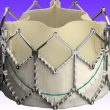Pure aortic regurgitation has historically been considered a contraindication for transcatheter aortic valve replacement (TAVR) due to the absence of calcification and subsequent device anchoring problems it poses. Initial reports on first-generation self-expanding valves for the treatment of pure regurgitation were somewhat discouraging, but devices evolved, adding repositioning capacity, different external skirts (pericardial, PET, urethane,<a href="https://solaci.org/en/2017/12/26/tavr-in-pure-aortic-regurgitation-new-devices-new-outcomes/" title="Read more" >...</a>
Cardiac Damage: Should we start to assess it?
Courtesy of Dr. Carlos Fava. The current recommendation for aortic valve replacement is based on stenosis severity based on valvular criteria (mean transvalvular gradient, peak aortic velocity and valve index area) and the presence of symptoms, in addition to comorbidities, mainly for risk stratification. However, ventricular damage and/or its effect on cardiovascular hemodynamics are not regarded<a href="https://solaci.org/en/2017/12/20/cardiac-damage-should-we-start-to-assess-it/" title="Read more" >...</a>
Failing Surgical Bioprosthesis: A Challenge on the Rise
Courtesy of Dr. Carlos Fava. The gold standard for failing aortic bioprosthesis has traditionally been surgery. However, since the first valve in valve (TAV-in-SAV) report in 2007, by Wenaweser, transcatheter valve implantation has emerged as a valid alternative. Even so, at present there is not enough scientific evidence in this regard. The present study analyzed<a href="https://solaci.org/en/2017/12/15/failing-surgical-bioprosthesis-a-challenge-on-the-rise/" title="Read more" >...</a>
TAVR in Patients with Pure vs. Mixed Aortic Stenosis: Benefits and Evolution
Courtesy of Dr. Carlos Fava. Transcatheter aortic valve replacement (TAVR) has been proven to reduce mortality and improve the quality of life of patients with pure severe aortic stenosis (PAS). However, there is a significant number of patients who experience mixed aortic stenosis associated with moderate/severe aortic regurgitation (MAS). These subjects were excluded from the PARTNER<a href="https://solaci.org/en/2017/12/12/tavr-in-patients-with-pure-vs-mixed-aortic-stenosis-benefits-and-evolution/" title="Read more" >...</a>
Peripheral Vascular Disease Is Associated to More Events in TAVR
Courtesy of Dr. Carlos Fava. The incidence of peripheral vascular disease (PVD) is increasing and associated with negative outcomes when overlapping with cardiovascular disease. In patients undergoing TAVR, its prevalence varies between 28% and 42%, according to different studies. However, its real impact on the rate of survival is still unclear. This study analyzed 27,440 patients >65 years<a href="https://solaci.org/en/2017/12/11/peripheral-vascular-disease-is-associated-to-more-events-in-tavr/" title="Read more" >...</a>
Lung Disease and TAVR: Beneficial for a Reduced Group of Patients
Chronic Lung Disease often affects patients with severe aortic stenosis undergoing transcatheter aortic valve replacement (TAVR) or surgery. In fact, this is why patients with lung disease are often deemed inoperable and prescribed TAVR. This is the first time the benefit of TAVR has been assessed in this group of patients, for symptoms of these conditions can<a href="https://solaci.org/en/2017/11/21/lung-disease-and-tavr-beneficial-for-a-reduced-group-of-patients/" title="Read more" >...</a>
Here you will find the last news about TAVR
1) New Study Confirms TAVR Durability at 5 Years The ADVANCE study was designed to evaluate the safety and effectiveness of transcatheter aortic valve replacement (TAVR) with self-expanding prosthesis CoreValve in “real world” patients with symptomatic, severe aortic stenosis at high surgical risk. Read the conclusions of this study 2) An Important Study Shows That Renal Function Must Be Cared for in<a href="https://solaci.org/en/2017/11/15/here-you-will-find-the-last-news-about-tavr/" title="Read more" >...</a>
Efficacy of Micromesh-Covered Stents in Carotid Artery Stenting
Most literature, old and recent, associates carotid artery stenting with a higher rate of stroke (although minor) when compared with carotid endarterectomy during the acute period. However, 30-day outcomes of angioplasty and surgery are comparable. Many technical advancements, including new stent designs and different cerebral protection mechanisms, have improved the outcomes of angioplasty in clinical<a href="https://solaci.org/en/2017/11/10/efficacy-of-micromesh-covered-stents-in-carotid-artery-stenting/" title="Read more" >...</a>
TCT 2017 | ORBITA: The Placebo Effect of Angioplasty
Courtesy of the SBHCI. Chronic stable angina and severe coronary lesion patients who undergo angioplasty in a single vessel show no better outcomes than individuals who undergo a placebo sham procedure when it comes to exercise capacity and symptoms, according to this study presented at TCT and published simultaneously in the Lancet. The curious results<a href="https://solaci.org/en/2017/11/06/tct-2017-orbita-the-placebo-effect-of-angioplasty/" title="Read more" >...</a>
TCT 2017 | PREVAIL: Final Outcomes of the Watchman Device
Courtesy of SBHCI. The final 5-year outcomes of the PROTECT AF and PREVAIL studies (which assessed the left atrial appendage closure device Watchman) continues to show similar stroke prevention rate to that of warfarin, though with a clear reduction in bleeding. The meta-analysis showed a significant reduction in hemorrhagic stroke (0.17% vs 0.87%), non-procedure related<a href="https://solaci.org/en/2017/11/06/tct-2017-prevail-final-outcomes-of-the-watchman-device/" title="Read more" >...</a>









